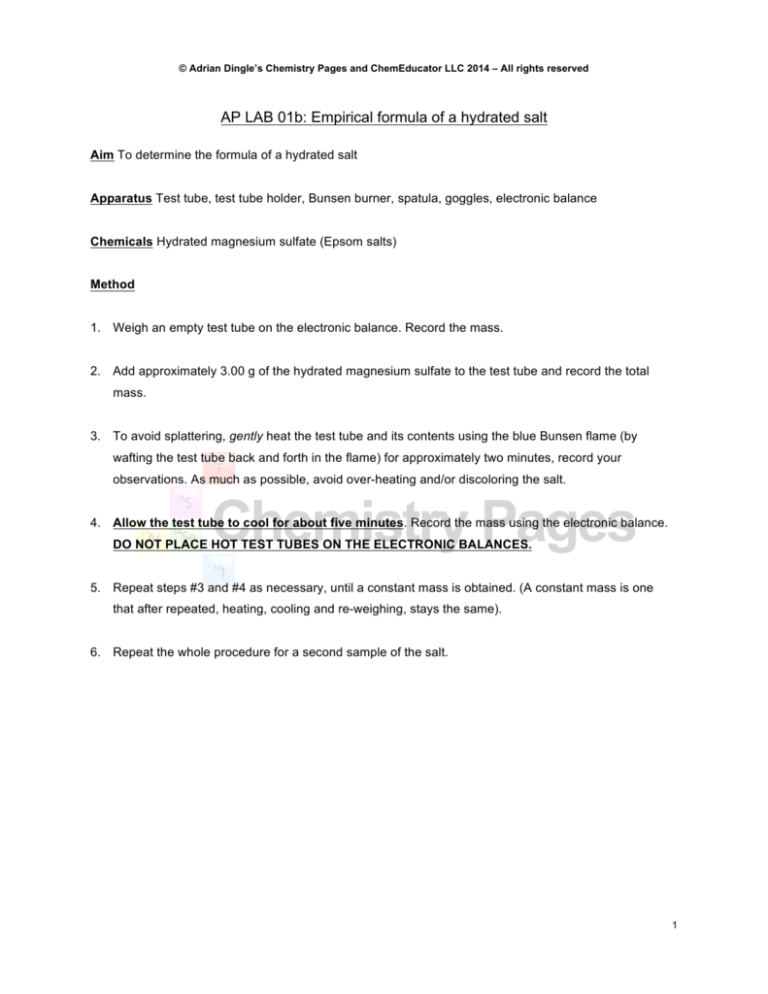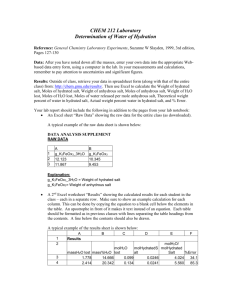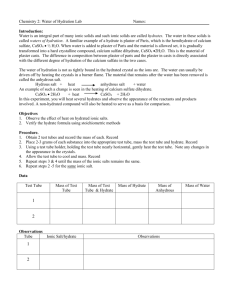
© Adrian Dingle’s Chemistry Pages and ChemEducator LLC 2014 – All rights reserved
AP LAB 01b: Empirical formula of a hydrated salt
Aim To determine the formula of a hydrated salt
Apparatus Test tube, test tube holder, Bunsen burner, spatula, goggles, electronic balance
Chemicals Hydrated magnesium sulfate (Epsom salts)
Method
1. Weigh an empty test tube on the electronic balance. Record the mass.
2. Add approximately 3.00 g of the hydrated magnesium sulfate to the test tube and record the total
mass.
3. To avoid splattering, gently heat the test tube and its contents using the blue Bunsen flame (by
wafting the test tube back and forth in the flame) for approximately two minutes, record your
observations. As much as possible, avoid over-heating and/or discoloring the salt.
4. Allow the test tube to cool for about five minutes. Record the mass using the electronic balance.
DO NOT PLACE HOT TEST TUBES ON THE ELECTRONIC BALANCES.
5. Repeat steps #3 and #4 as necessary, until a constant mass is obtained. (A constant mass is one
that after repeated, heating, cooling and re-weighing, stays the same).
6. Repeat the whole procedure for a second sample of the salt.
1
© Adrian Dingle’s Chemistry Pages and ChemEducator LLC 2014 – All rights reserved
Results
Observations
st
1 Sample
2
nd
Sample
Mass of empty test tube
Mass of test tube + hydrated salt BEFORE heating
Mass of test tube + salt after first heating and cooling cycle
Mass of test tube + salt after second heating and cooling
cycle
Mass of test tube + salt after third heating and cooling cycle
Mass of test tube + salt after fourth heating and cooling cycle
Mass of test tube + salt after fifth heating and cooling cycle
Mass of test tube + salt after sixth heating and cooling cycle.
etc.
2
© Adrian Dingle’s Chemistry Pages and ChemEducator LLC 2014 – All rights reserved
Conclusion/Calculation
1. Perform the calculations below.
st
1 Sample
2
nd
Sample
(i) Calculate the mass of hydrated salt added to the test tube at the start of the experiment.
(ii) Calculate the mass of the anhydrous (without water) salt at the end of the experiment.
(iii) Calculate the mass of water driven off by heating the hydrated salt.
(iv) Calculate the moles of the anhydrous (without water) salt present.
(v) Calculate the moles of water driven off by heating.
(vi) Compare your answers to (iv) & (v) in order to determine the formula of the hydrated salt.
2. In another similar experiment, a student heats the hydrated salt carelessly and some of the salt spits
out of the test tube. What would be the effect of this experimental error on the calculation of the
formula of the hydrated salt?
3








